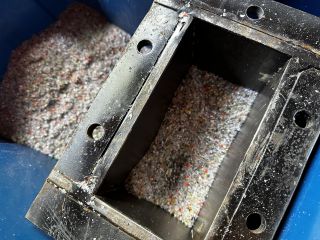Difference between revisions of "DPR at CCXii"
(Created page with "The first DPR session took place at CCXii in May 2024.<BR> Our lab was setup in our tool shed which is in shipping con...") |
|||
| (16 intermediate revisions by the same user not shown) | |||
| Line 1: | Line 1: | ||
The first DPR session took place at [[Disorient_presents:_CCXII_-_Possibilities_of_Pattern|CCXii]] in May 2024.<BR> | The first DPR session took place at [[Disorient_presents:_CCXII_-_Possibilities_of_Pattern|CCXii]] in May 2024.<BR> | ||
The DPR lab was setup in our tool shed in a shipping container and included the shredder, the press and a new die.<BR> | |||
After Jack assembled the missing electrical cable to power our 230v shredder from various electrical components we had on site, we were able to run the shredder successfully and | ===First test=== | ||
After Jack assembled the missing electrical cable to power our 230v shredder from various electrical components we had on site, we were able to run the shredder successfully and reduce most plastic items that we fed it.<BR> | |||
We had designed and fabricated (with Simas's help) the die so it could be filled with our plastic shreds but we didn't take into account that it would require a lot more pressure and/or heat to create the brick | We had designed and fabricated (with Simas's help) the die so it could be filled with our plastic shreds but we didn't take into account that it would require a lot more pressure and/or heat to successfully create the brick out of the compressed plastic shreds.<BR> | ||
We had to find a way to extent the interface of the press, a metal cylinder about 2" diameter, so it could touch the top plate that was pressed down the die to compress the content into a solid brick. We overestimated the rating of the press for the surface of that cylinder which means that the pressure on the 3"x6" plate was much less than 20 tons per square inch. | |||
After compressing the plastic shreds to the maximum of the press capacity we ended-up with a volume that did not hold its shape and fizzled apart as we tried to extract it from the die. We also slightly misaligned the setup which led to jamming the top plate into the die and bending one of the two support beams. It took many violent attempts to free the jammed plate. | |||
===Notes=== | |||
1. Pre-sort plastics. We were trying to avoid this to keep the process as simple as possible but pre-sorting is a relatively easy step that will allow us greater control over the following steps;<BR> | |||
2. Make a smaller die, possibly a 2" diameter cylinder to cast a flat cylinder like a coin or a medal;<BR> | |||
3. Design a solution to heat-up the die to soften the plastic before and during compression.<BR> | |||
<gallery widths=280 heights=160 mode="packed-hover"> | |||
Image:CCXii.DPRLab.7.jpg | |||
Image:CCXii.DPRLab.8.jpg | |||
Image:CCXii.DPRLab.9.jpg | |||
Image:CCXii.DPRLab.6.jpg | |||
Image:CCXii.DPRLab.10.jpg | |||
Image:CCXii.DPRLab.11.jpg | |||
Image:CCXii.DPRLab.12.jpg | |||
Image:CCXii.DPRLab.13.jpg | |||
Image:CCXii.DPRLab.14.jpg | |||
Image:CCXii.DPRLab.4.jpg | |||
Image:CCXii.DPRLab.5.jpg | |||
Image:CCXii.DPRLab.1.jpg | |||
Image:CCXii.DPRLab.15.jpg | |||
Image:CCXii.DPRLab.2.jpg | |||
Image:CCXii.DPRLab.3.jpg | |||
</gallery><BR> | |||
{{:Disorient_Plastic_Recycling_footer_nav}} | |||
Latest revision as of 19:18, 3 May 2025
The first DPR session took place at CCXii in May 2024.
The DPR lab was setup in our tool shed in a shipping container and included the shredder, the press and a new die.
First test
After Jack assembled the missing electrical cable to power our 230v shredder from various electrical components we had on site, we were able to run the shredder successfully and reduce most plastic items that we fed it.
We had designed and fabricated (with Simas's help) the die so it could be filled with our plastic shreds but we didn't take into account that it would require a lot more pressure and/or heat to successfully create the brick out of the compressed plastic shreds.
We had to find a way to extent the interface of the press, a metal cylinder about 2" diameter, so it could touch the top plate that was pressed down the die to compress the content into a solid brick. We overestimated the rating of the press for the surface of that cylinder which means that the pressure on the 3"x6" plate was much less than 20 tons per square inch.
After compressing the plastic shreds to the maximum of the press capacity we ended-up with a volume that did not hold its shape and fizzled apart as we tried to extract it from the die. We also slightly misaligned the setup which led to jamming the top plate into the die and bending one of the two support beams. It took many violent attempts to free the jammed plate.
Notes
1. Pre-sort plastics. We were trying to avoid this to keep the process as simple as possible but pre-sorting is a relatively easy step that will allow us greater control over the following steps;
2. Make a smaller die, possibly a 2" diameter cylinder to cast a flat cylinder like a coin or a medal;
3. Design a solution to heat-up the die to soften the plastic before and during compression.














